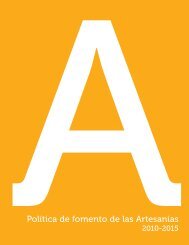Conociendo la Cultura Colla - Consejo Nacional de la Cultura y las ...
Conociendo la Cultura Colla - Consejo Nacional de la Cultura y las ...
Conociendo la Cultura Colla - Consejo Nacional de la Cultura y las ...
Create successful ePaper yourself
Turn your PDF publications into a flip-book with our unique Google optimized e-Paper software.
<strong>Conociendo</strong> <strong>la</strong> cultura<br />
Knowing the Col<strong>la</strong> Culture<br />
turismo<br />
cultural
<strong>Conociendo</strong> <strong>la</strong> cultura<br />
Knowing the Col<strong>la</strong> Culture
<strong>Conociendo</strong> <strong>la</strong> cultura<br />
Knowing the Col<strong>la</strong> Culture<br />
turismo<br />
cultural
CONOCIENDO LA CULTURA COLLA<br />
Publicación a cargo <strong>de</strong>: Cristina Gálvez Gómez (CNCA)<br />
Coordinación editorial: Christian Báez Allen<strong>de</strong> (CNCA)<br />
E<strong>la</strong>boración <strong>de</strong> contenidos: Cristina Gálvez Gómez (CNCA)<br />
Asesoría <strong>de</strong> contenidos: Roberto Salinas Cortés,<br />
Presi<strong>de</strong>nte Comunidad Col<strong>la</strong> Río Jorquera y sus Afluentes<br />
Corrección <strong>de</strong> textos en español: Mónica Muñoz Montoya (CNCA)<br />
Diseño y diagramación: Soledad Poirot Oliva (CNCA)<br />
Diseño <strong>de</strong> portada: Emilia Valle Krämer (CNCA)<br />
Traducción al inglés: Paz Sepúlveda Vidal<br />
Ilustraciones: Patricia Aguilera Álvarez (Ají color)<br />
© <strong>Consejo</strong> <strong>Nacional</strong> <strong>de</strong> <strong>la</strong> <strong>Cultura</strong> y <strong>la</strong>s Artes<br />
Registro <strong>de</strong> Propiedad Intelectual n° 223.472<br />
ISBN: 978-956-352-026-2<br />
www.cultura.gob.cl<br />
Se autoriza <strong>la</strong> reproducción parcial citando <strong>la</strong> fuente correspondiente.<br />
En este libro se utilizó para el cuerpo <strong>de</strong> texto <strong>la</strong> tipografía Australis,<br />
creada por el diseñador chileno Francisco Gálvez, fuente ganadora<br />
<strong>de</strong>l Gold Prize en los Morisawa Awards 2002 <strong>de</strong> Tokio.<br />
1ª edición diciembre <strong>de</strong> 2012<br />
Se imprimieron 1.250 ejemp<strong>la</strong>res<br />
Impreso en Quad/Graphics<br />
Santiago, Chile
ÍNDICE<br />
08 Presentación<br />
10 Introducción<br />
14 Características generales<br />
18 Cosmovisión<br />
22 Historia<br />
27 Territorio, sitios y símbolos <strong>de</strong> significación cultural<br />
29 Salud y medicina<br />
30 Vestimenta<br />
30 Gastronomía<br />
37 Música<br />
37 Artesanía<br />
39 Glosario<br />
KNOWING THE COLLA CULTURE<br />
42 Presentation<br />
44 Introduction<br />
48 General characteristics<br />
50 World view<br />
54 History<br />
59 Territory, sites and symbols of cultural significance<br />
61 Health and Medicine<br />
62 Clothing<br />
64 Cuisine<br />
69 Music<br />
69 Craft<br />
71 Glossary<br />
72 Bibliografía
PRESENTACIÓN<br />
Nuestras guías <strong>de</strong> diálogo intercultural para el turismo indígena,<br />
tienen por objeto promover el respeto y <strong>la</strong>s buenas prácticas<br />
entre el turista nacional o extranjero y los pueblos originarios.<br />
Estas guías sitúan al viajero, al “otro”, <strong>de</strong>ntro <strong>de</strong>l territorio físico<br />
y mental <strong>de</strong> <strong>la</strong> cultura con que están entrando en contacto:<br />
en el<strong>la</strong>s encontrarán su cosmovisión, costumbres, estructura<br />
social y formas <strong>de</strong> re<strong>la</strong>cionarse, entre otras valiosas informaciones<br />
que enriquecerán <strong>la</strong> experiencia y el intercambio cultural.<br />
Cada guía está diseñada para facilitar <strong>la</strong> comprensión y el sentido<br />
<strong>de</strong> <strong>la</strong> comunicación intercultural <strong>de</strong>s<strong>de</strong> un prisma cercano<br />
a <strong>la</strong>s culturas indígenas, en don<strong>de</strong> con frecuencia lo material<br />
no está divorciado <strong>de</strong> lo inmaterial y se conjugan <strong>la</strong> realidad<br />
con <strong>la</strong> imaginería, lo posible con lo imposible como parte <strong>de</strong> un<br />
todo. Estos grupos étnicos tienen una visión particu<strong>la</strong>r tanto<br />
<strong>de</strong> su entorno, como <strong>de</strong> sí mismos, con una fuerte raigambre<br />
en sus ancestros y con el territorio que l<strong>la</strong>man hogar. El reconocimiento<br />
a estos pueblos abre <strong>la</strong> posibilidad <strong>de</strong> acce<strong>de</strong>r a <strong>la</strong><br />
incomparable riqueza cognitiva que poseen sobre los lugares<br />
que pueb<strong>la</strong>n, que también son, muchas veces, atractivos <strong>de</strong>stinos<br />
turísticos. Por otra parte, estas visitas reportan beneficios<br />
económicos a estas comunida<strong>de</strong>s, y no <strong>de</strong>ben necesariamente,<br />
comprometer <strong>la</strong> integridad <strong>de</strong>l patrimonio natural y cultural,<br />
sino enriquecerse mutuamente. Es vital que <strong>la</strong> re<strong>la</strong>ción<br />
<strong>de</strong> mutuo beneficio entre visitantes y pueblos originarios sea<br />
por <strong>de</strong>finición sustentable y releve lo valores <strong>de</strong> preservación e<br />
interculturalidad. Ese es el objetivo que busca promover esta<br />
publicación y el trabajo que realizamos como institución para<br />
fomentar un turismo cultural sustentable.<br />
El mayor <strong>de</strong>safío es lograr transmitir al usuario <strong>de</strong> estas guías<br />
una <strong>de</strong>scripción apropiada y efectiva <strong>de</strong> <strong>la</strong> cosmogonía <strong>de</strong> estos<br />
pueblos, <strong>de</strong> modo que el acercamiento sea enriquecedor para<br />
8
<strong>la</strong>s partes. Este <strong>de</strong>licado ba<strong>la</strong>nce <strong>de</strong>be consi<strong>de</strong>rar el hecho <strong>de</strong><br />
que tradicionalmente los mecanismos <strong>de</strong> transmisión <strong>de</strong> este<br />
tipo <strong>de</strong> conocimiento han sido orales, en lo fundamental a través<br />
<strong>de</strong> cuentos, leyendas, narraciones, mitos y canciones. Con<br />
esto, invitamos al visitante a vivir una singu<strong>la</strong>r experiencia<br />
turística cultural, protagonizada por comunida<strong>de</strong>s o familias<br />
indígenas insertas <strong>de</strong>ntro <strong>de</strong> su entorno natural, don<strong>de</strong> sus<br />
costumbres y tradiciones ancestrales hal<strong>la</strong>n una armoniosa<br />
simbiosis con su forma <strong>de</strong> vida actual. Esperamos que este material<br />
sea una ayuda eficaz para facilitar un encuentro y diálogo<br />
significativo entre culturas.<br />
Luciano Cruz-Coke Carvallo<br />
Ministro Presi<strong>de</strong>nte<br />
<strong>Consejo</strong> <strong>Nacional</strong> <strong>de</strong> <strong>la</strong> <strong>Cultura</strong> y <strong>la</strong>s Artes<br />
9
INTRODUCCIÓN<br />
El turismo cultural se encuentra en fase <strong>de</strong> crecimiento y el turismo<br />
indígena es parte <strong>de</strong> él. Se particu<strong>la</strong>riza porque el turista interesado<br />
<strong>de</strong>sea sostener un estrecho contacto con <strong>la</strong>s pob<strong>la</strong>ciones<br />
anfitrionas -comunida<strong>de</strong>s o familias indígenas-, para conocer sus<br />
costumbres presentes y ancestrales. Lo que seduce <strong>de</strong> estos viajes<br />
es su promesa <strong>de</strong> paisaje y <strong>la</strong> oportunidad <strong>de</strong> diálogo hacia otro<br />
tiempo y cultura. Esas experiencias nos conducen a un p<strong>la</strong>no interior,<br />
al <strong>de</strong> <strong>la</strong> especie humana; y <strong>la</strong> riqueza que se adquiere en el<br />
turismo indígena, radica en ese contacto con otras maneras posibles<br />
<strong>de</strong> percibir y construir <strong>la</strong> realidad. Es un intercambio con<br />
grupos humanos que han <strong>de</strong>venido en subalternos en el mapa <strong>de</strong><br />
<strong>la</strong>s ten<strong>de</strong>ncias dominantes <strong>de</strong>l escenario global.<br />
La Guía <strong>de</strong> diálogo intercultural para el turismo indígena es una iniciativa<br />
<strong>de</strong> <strong>la</strong> Sección <strong>de</strong> Patrimonio <strong>Cultura</strong>l <strong>de</strong>l <strong>Consejo</strong> <strong>Nacional</strong><br />
<strong>de</strong> <strong>la</strong> <strong>Cultura</strong> y <strong>la</strong>s Artes, y busca ser un aporte en el proceso <strong>de</strong><br />
intercambio que se genera entre visitantes y anfitriones, cuando<br />
el <strong>de</strong>stino <strong>de</strong>l viaje elegido involucra el contacto entre seres humanos<br />
que provienen <strong>de</strong> cosmovisiones muy diversas.<br />
El turismo sostenible es una oportunidad para contribuir al<br />
<strong>de</strong>sarrollo <strong>de</strong> realida<strong>de</strong>s socio-económicas <strong>de</strong>sventajadas, pero<br />
haciendo eco <strong>de</strong> los aprendizajes <strong>de</strong> los <strong>de</strong>stinos turísticos maduros<br />
que se han visto dañados por <strong>la</strong> falta <strong>de</strong> regu<strong>la</strong>ción. En<br />
<strong>la</strong> actualidad, este se focaliza en <strong>la</strong> autogestión y <strong>la</strong> custodia <strong>de</strong><br />
valores compartidos en manos <strong>de</strong> <strong>la</strong>s propias comunida<strong>de</strong>s y<br />
sus familias: “Para entregar bienestar es absolutamente esencial<br />
que cualquier estrategia <strong>de</strong> turismo tenga repercusión y apoyo<br />
local en base a valores comunes. Del mismo modo se <strong>de</strong>be reconocer<br />
el bienestar más allá <strong>de</strong> lo económico, que incluya el<br />
bienestar social, cultural, psicológico, espiritual, emocional y<br />
físico, todos los cuales <strong>de</strong>pen<strong>de</strong>n <strong>de</strong> un medio ambiente saludable.<br />
Cualquier estrategia <strong>de</strong> turismo <strong>de</strong>be tener un mensaje<br />
10
común: el patrimonio cultural y natural son indivisibles, y el<br />
bienestar y <strong>de</strong>sarrollo <strong>de</strong> <strong>la</strong> pob<strong>la</strong>ción no es separable <strong>de</strong>l bienestar<br />
y sustento <strong>de</strong>l medio ambiente”. 1<br />
Este enfoque <strong>de</strong> integridad entre patrimonio natural y cultural,<br />
se correspon<strong>de</strong> con <strong>la</strong> cosmovisión indígena que hace convivir lo<br />
material con lo inmaterial, <strong>la</strong> realidad con <strong>la</strong> imaginería, lo posible<br />
con lo imposible. Son escasos los instrumentos públicos<br />
interculturales que reflejan esta mirada, pareciendo ser los que<br />
mejor facilitan <strong>la</strong> comprensión y <strong>la</strong> comunicación que se <strong>de</strong>sea<br />
estimu<strong>la</strong>r. Esta guía preten<strong>de</strong> aportar a este <strong>de</strong>safío.<br />
Cristina Gálvez Gómez<br />
Encargada Programa Turismo <strong>Cultura</strong>l<br />
Sección Patrimonio <strong>Cultura</strong>l<br />
Departamento Ciudadanía y <strong>Cultura</strong><br />
1. Robyn Bushell, Juan F. Sa<strong>la</strong>zar (2009): Estudio <strong>de</strong> prefactibilidad. Turismo indígena en San<br />
Pedro <strong>de</strong> Atacama, Centro <strong>de</strong> Investigaciones <strong>Cultura</strong>les, Universidad <strong>de</strong> Western<br />
Sydney, Australia.<br />
11
CARACTERÍSTICAS GENERALES<br />
El pueblo col<strong>la</strong> es trashumante por excelencia; se <strong>de</strong>fine como un<br />
pueblo <strong>de</strong> altura, <strong>de</strong> nieve, <strong>de</strong> frío y <strong>de</strong> <strong>la</strong> puna. Hoy habitan <strong>la</strong><br />
zona cordillerana <strong>de</strong> <strong>la</strong> Región <strong>de</strong> Atacama en Chile y <strong>la</strong>s localida<strong>de</strong>s<br />
argentinas <strong>de</strong> Fiambalá, Laguna Gran<strong>de</strong>, Jachal, Saujil, Tinogasta,<br />
Belén y Catamarca, entre otras.<br />
Las primeras referencias a los col<strong>la</strong> se remiten a los más antiguos<br />
habitantes <strong>de</strong>l Titicaca, y por extensión, al mundo andino. 1 A<strong>de</strong>más<br />
su historia se vincu<strong>la</strong> a acontecimientos <strong>de</strong>sarrol<strong>la</strong>dos en<br />
<strong>la</strong>s culturas <strong>de</strong> los pueblos asentados en Pucará Tiwanaku y Hatuncol<strong>la</strong>.<br />
Son una mezc<strong>la</strong> <strong>de</strong> pueblos provenientes <strong>de</strong> Bolivia que<br />
“ocuparon <strong>la</strong>s provincias <strong>de</strong>l noroeste <strong>de</strong> Argentina para <strong>de</strong>sp<strong>la</strong>zarse<br />
durante los siglos XV y XVI entre <strong>la</strong>s dos <strong>la</strong><strong>de</strong>ras cordilleranas”. 2<br />
Durante <strong>la</strong> colonia, en <strong>la</strong>s sierras, <strong>la</strong> puna, el <strong>de</strong>sierto, en <strong>la</strong>s<br />
regiones áridas <strong>de</strong> Atacama, en Tucumán, Catamarca y Jujuy,<br />
se les conocía como los “indígenas <strong>de</strong> aspecto altiplánico acostumbrados<br />
al rigor <strong>de</strong>l frío, el viaje y <strong>la</strong> soledad” 3 que circu<strong>la</strong>n<br />
por valles y quebradas cordilleranas.<br />
Estos diversos pueblos son reconocidos como un grupo diferenciado<br />
recién a mediados <strong>de</strong>l siglo XIX. Los re<strong>la</strong>tos que se incluyen<br />
en los estudios sobre ellos, sugieren que <strong>la</strong> expresión col<strong>la</strong> se usaba<br />
en esa época para i<strong>de</strong>ntificar a los indígenas que habitaban <strong>la</strong>s<br />
quebradas y el extremo austral <strong>de</strong> <strong>la</strong> puna <strong>de</strong>l norte chileno, <strong>de</strong>l<br />
noroeste argentino y <strong>de</strong>l sur <strong>de</strong> Bolivia.<br />
A este amplio espacio, en que emerge esta etnia, se le <strong>de</strong>nomina<br />
área circumpuneña, <strong>la</strong> que se extien<strong>de</strong> <strong>de</strong>s<strong>de</strong> el sur <strong>de</strong>l Sa<strong>la</strong>r<br />
<strong>de</strong> Uyuni, abarcando el altip<strong>la</strong>no <strong>de</strong> Lípez, <strong>la</strong> Puna <strong>de</strong> Jujuy y<br />
<strong>la</strong> Puna <strong>de</strong> Atacama, hasta aproximadamente el paso San Fran-<br />
1. <strong>Consejo</strong> <strong>Nacional</strong> <strong>de</strong> <strong>la</strong> <strong>Cultura</strong> y <strong>la</strong>s Artes (2011): Informe estudio <strong>de</strong>l pueblo col<strong>la</strong>.<br />
2. Daniel Quiroz y Yuri Jeria, Etnogénesis e i<strong>de</strong>ntidad cultural entre los grupos col<strong>la</strong> <strong>de</strong> <strong>la</strong> Cordillera<br />
<strong>de</strong> Atacama. Mimeo.<br />
3. Hernán Sa<strong>la</strong>s y Rafael Pérez Taylor (editores) (2004): Desierto y frontera, el norte <strong>de</strong> México<br />
y otros contextos culturales, México, Instituto <strong>de</strong> Investigaciones Antropológicas.<br />
14
cisco. Integra a<strong>de</strong>más <strong>la</strong>s vertientes cordilleranas oriental y occi<strong>de</strong>ntal<br />
que bor<strong>de</strong>an <strong>la</strong>s tierras altas. Estas <strong>de</strong>limitaciones son<br />
muy imprecisas, abarcando por el occi<strong>de</strong>nte el <strong>de</strong>sierto <strong>de</strong>s<strong>de</strong> el<br />
norte <strong>de</strong>l río Loa hasta Chañaral (incluyendo el litoral, los oasis y<br />
quebradas). Por el oriente, incluye más al sur, <strong>la</strong>s cercanías <strong>de</strong> los<br />
valles <strong>de</strong> Jujuy y Salta.<br />
Des<strong>de</strong> hace milenios, estos pueblos <strong>de</strong>nominados col<strong>la</strong>, han tenidos<br />
dinámicas <strong>de</strong> interacción <strong>de</strong>ntro <strong>de</strong>l área circumpuneña, mediante<br />
el intercambio <strong>de</strong> recursos productivos y <strong>de</strong> recolección<br />
que favorecían los distintos estratos y eco-zonas. Sin embargo,<br />
por encima <strong>de</strong> <strong>la</strong>s diferencias regionales, se percibe una coherencia<br />
económica compartida, que se expresa en <strong>la</strong> materialización<br />
<strong>de</strong> diferentes patrones <strong>de</strong> complementariedad política, social y<br />
económica; base para <strong>la</strong> construcción <strong>de</strong> re<strong>la</strong>ciones <strong>de</strong> intercambio<br />
<strong>de</strong> bienes y <strong>de</strong> establecimiento <strong>de</strong> re<strong>la</strong>ciones entre grupos humanos<br />
para procurarse el acceso a recursos y a diferentes productos<br />
consi<strong>de</strong>rados necesarios para su subsistencia. 4<br />
La gana<strong>de</strong>ría <strong>de</strong> camélidos era <strong>la</strong> base <strong>de</strong> <strong>la</strong> economía, tanto por<br />
sus subproductos como por su capacidad <strong>de</strong> carga, que facilitaba<br />
<strong>la</strong> movilidad y el intercambio entre los distintos pueblos que<br />
habitaban el área. Una <strong>de</strong> <strong>la</strong>s características <strong>de</strong> estos diferentes<br />
grupos es <strong>la</strong> trashumancia <strong>de</strong> carácter pastoril.<br />
4. <strong>Consejo</strong> <strong>Nacional</strong> <strong>de</strong> <strong>la</strong> <strong>Cultura</strong> y <strong>la</strong>s Artes: op. cit.<br />
15
COSMOVISIÓN<br />
Las prácticas culturales col<strong>la</strong> están vincu<strong>la</strong>das a <strong>la</strong> cosmovisión<br />
<strong>de</strong>l mundo andino. “La cosmovisión col<strong>la</strong> <strong>de</strong>l mundo, su base<br />
i<strong>de</strong>ológica y religiosa, los acerca a los indígenas <strong>de</strong>l norte <strong>de</strong><br />
Chile. Su concepción personal <strong>de</strong>l universo y <strong>de</strong> <strong>la</strong> humanidad<br />
perdura en <strong>la</strong> conciencia <strong>de</strong>l pueblo andino. A través <strong>de</strong> sus<br />
fiestas privadas en el hogar y en <strong>la</strong> montaña po<strong>de</strong>mos percibir<br />
<strong>la</strong>s prácticas religiosas andinas unidas a <strong>la</strong> religión cristiana”. 5<br />
La figura <strong>de</strong> Dios y todas <strong>la</strong>s tradiciones, convergen en <strong>la</strong> Pachamama<br />
que tiene un papel integrador <strong>de</strong> todas <strong>la</strong>s energías. Los<br />
col<strong>la</strong> creen en los espíritus guías, en <strong>la</strong>s almas, ánimas y en Tata<br />
Sol y Mama Luna.<br />
Celebran a los santos, que a<strong>de</strong>más tienen una significación especial:<br />
son los protectores y espíritus guías. También creen en<br />
otro tipo <strong>de</strong> espíritus, como el Kukamu<strong>la</strong>, espíritu maligno que<br />
se manifiesta a través <strong>de</strong>l grito <strong>de</strong> un animal; el Yastai espíritu<br />
bueno y el Peuchén, animal que chupa <strong>la</strong> sangre a otros animales.<br />
Para ahuyentarlo <strong>de</strong> los corrales, los col<strong>la</strong> utilizan huesos <strong>de</strong><br />
cabezas <strong>de</strong> cabra y espejos.<br />
Los 1º <strong>de</strong> noviembre celebran el Día <strong>de</strong> <strong>la</strong>s almas, ánimas y espíritus.<br />
Para el año nuevo indígena, el 21 <strong>de</strong> junio, celebran lo<br />
que se conoce como el Renuevo <strong>de</strong>l año. 6<br />
Dentro <strong>de</strong> su comunidad existen hombres y mujeres religiosos,<br />
que curan enfermeda<strong>de</strong>s y ofician <strong>de</strong> parteros, comunicándose<br />
siempre con <strong>la</strong> naturaleza y sus fuerzas: astros, animales y agua.<br />
El mundo col<strong>la</strong> presenta una re<strong>la</strong>ción sagrada con su entorno,<br />
levantando en su territorio oratorios y apachetas. Estas últimas<br />
5. Cervellino, Miguel (1993): "Ritos col<strong>la</strong> en <strong>la</strong> Región <strong>de</strong> Atacama", Santiago,<br />
Revista Museos, N° 15, Dirección <strong>de</strong> Archivos y Museos.<br />
6. Informe <strong>de</strong> <strong>la</strong> Comisión Verdad Histórica y Nuevo Trato (octubre 2008): “Informe grupo trabajo<br />
pueblo Col<strong>la</strong>”, Volumen 3, anexo tomo I, editado por el Comisionado Presi<strong>de</strong>ncial<br />
para Asuntos Indígenas.<br />
18
son lugares escogidos por <strong>la</strong> comunidad para realizar todas sus<br />
ceremonias y rituales.<br />
Frente a situaciones como viajes y cosechas, presentan ofrendas<br />
mediante el mechero, cuyo combustible es grasa animal. Otros<br />
ritos son realizados para agra<strong>de</strong>cer y solicitar <strong>la</strong> multiplicación<br />
<strong>de</strong>l ganado, estos son <strong>la</strong>s Vi<strong>la</strong>nchas y <strong>la</strong>s Ofrendas <strong>de</strong> Mesas.<br />
En <strong>la</strong>s primeras se sacrifica el mejor animal <strong>de</strong> <strong>la</strong> manada; y en<br />
<strong>la</strong>s segundas se ofrecen diversas figuras <strong>de</strong> elementos <strong>de</strong> uso<br />
cotidiano y mágico, confeccionados con harina y agua. Los col<strong>la</strong><br />
tienen cuatro colores que los i<strong>de</strong>ntifican: amarillo, negro, b<strong>la</strong>nco<br />
y rojo: “El color amarillo representa a Tata Inti, Tata Sol; el<br />
color negro representa a <strong>la</strong> medicina, <strong>la</strong> cultura, <strong>la</strong>s ceremonias<br />
y los rituales; el color b<strong>la</strong>nco correspon<strong>de</strong> a <strong>la</strong> pureza, <strong>la</strong> montaña,<br />
<strong>la</strong> nieve, <strong>la</strong> cordillera y el color rojo representa <strong>la</strong> fuerza, el<br />
hombre, <strong>la</strong> sangre y el po<strong>de</strong>r”. 7<br />
7. Informe <strong>de</strong> <strong>la</strong> Comisión Verdad Histórica y Nuevo Trato: op. cit.<br />
19
HISTORIA<br />
El origen <strong>de</strong> este pueblo se encontraría en <strong>la</strong> unidad <strong>de</strong> ciertas<br />
agrupaciones indígenas localizadas en <strong>la</strong> región <strong>de</strong>l actual noroeste<br />
argentino (provincias <strong>de</strong> Jujuy, Salta y Catamarca), <strong>la</strong>s<br />
cuales comparten una i<strong>de</strong>ntidad étnico-cultural andina. 8 Surgirían,<br />
como categoría étnica, producto <strong>de</strong> <strong>la</strong> síntesis <strong>de</strong> distintas<br />
pob<strong>la</strong>ciones indígenas originarias y <strong>de</strong> otras tras<strong>la</strong>dadas durante<br />
<strong>la</strong> ocupación Inca y el tiempo colonial y <strong>de</strong> <strong>la</strong>s migraciones en el<br />
periodo republicano, en especial <strong>de</strong>s<strong>de</strong> Bolivia.<br />
Actualmente el pueblo col<strong>la</strong> se compone <strong>de</strong> un conjunto <strong>de</strong> comunida<strong>de</strong>s<br />
que habitan <strong>la</strong> cordillera <strong>de</strong> Los An<strong>de</strong>s en <strong>la</strong> región <strong>de</strong><br />
Atacama, específicamente en <strong>la</strong>s provincias <strong>de</strong> Copiapó y Chañaral,<br />
entre <strong>la</strong> quebrada Juncal por el norte y el río Copiapó por el sur.<br />
Las principales comunida<strong>de</strong>s se encuentran en El Salvador<br />
-sector Portal <strong>de</strong>l Inca-, Potrerillos, Quebrada Paipote, Quebrada<br />
San Miguel, Quebrada Carrizalillo y el Río Jorquera y<br />
sus Afluentes. Muchas familias col<strong>la</strong> también se han radicado<br />
en ciuda<strong>de</strong>s y pueblos, como Copiapó, Estación Paipote,<br />
Diego <strong>de</strong> Almagro, Inca <strong>de</strong> Oro, Tierra Amaril<strong>la</strong> y Los Loros.<br />
En virtud <strong>de</strong> <strong>la</strong> Ley Indígena, son nueve <strong>la</strong>s comunida<strong>de</strong>s reconocidas:<br />
1. Potrerillos<br />
2. Quebrada <strong>de</strong> Paipote<br />
3. Comunidad Río Jorquera y sus Afluentes<br />
4. Pastos Gran<strong>de</strong>s (Quebrada <strong>de</strong> Paipote)<br />
8. Algunos autores asocian a los col<strong>la</strong> actuales con el reino col<strong>la</strong> <strong>de</strong>l periodo Tiwanaku<br />
(400-1.000 d. C.) que se localizaban inmediatamente al sur <strong>de</strong>l <strong>la</strong>go Titicaca. Esta<br />
asociación no es sustentable, <strong>de</strong>bido a que los col<strong>la</strong> es una etnocategoría surgida en los<br />
últimos siglos. Ver: Carlos Rojas (1976): El mundo mágico <strong>de</strong> los col<strong>la</strong>s, Memoria, Universidad<br />
<strong>de</strong> Chile, La Serena; María Ester Grebe (1999): <strong>Cultura</strong>s Indígenas <strong>de</strong> Chile: Estudio<br />
preliminar, Editorial Pehuén, Santiago.<br />
22
5. Sinchi Waira (Quebrada <strong>de</strong> Paipote)<br />
6. Waira Manta Tuj’sí <strong>de</strong> Tierra Amaril<strong>la</strong><br />
7. Pacha Churi Kai <strong>de</strong> Los Loros<br />
8. Geocultuxial <strong>de</strong> Diego <strong>de</strong> Almagro<br />
9. Paipote <strong>de</strong> Estación Paipote<br />
La actual ocupación <strong>de</strong>l territorio se basa en <strong>la</strong> gana<strong>de</strong>ría trashumante<br />
(cabras, mu<strong>la</strong>s, caballos y ovejas) y cultivos en pequeña<br />
esca<strong>la</strong>. A<strong>de</strong>más, realizan activida<strong>de</strong>s asociadas a <strong>la</strong> pequeña minería,<br />
artesanía (ta<strong>la</strong>bartería, curtiembre, trabajo textil), recolección<br />
<strong>de</strong> leña y producción <strong>de</strong> carbón. El carácter trashumante<br />
y nóma<strong>de</strong> <strong>de</strong> este pueblo es su característica cultural fundamental.<br />
Al respecto, esta forma <strong>de</strong> ocupar el territorio está dada por <strong>la</strong><br />
disponibilidad <strong>de</strong> recursos <strong>de</strong> agua y alimento para sus animales.<br />
Es <strong>de</strong>cir, el pasto y el agua constituyen <strong>la</strong> base que <strong>de</strong>termina el<br />
circuito trashumante <strong>de</strong> <strong>la</strong> familia col<strong>la</strong>.<br />
Esta trashumancia traspasa <strong>la</strong>s fronteras geopolíticas, <strong>de</strong> acuerdo<br />
a los periodos <strong>de</strong> veranadas (asentamiento en <strong>la</strong>s zonas cordilleranas<br />
altas) e invernadas (asentamiento en <strong>la</strong>s zonas cordilleranas<br />
<strong>de</strong> menor altura):<br />
23
• Noroeste argentino hasta San Pedro <strong>de</strong> Atacama<br />
• Noroeste argentino hasta Copiapó<br />
• Copiapó hasta el noroeste argentino<br />
• Copiapó hasta San Pedro <strong>de</strong> Atacama<br />
A partir <strong>de</strong> 1894, con el establecimiento <strong>de</strong> <strong>la</strong> Compañía Minera<br />
<strong>de</strong> Potrerillos, comienzan los problemas ambientales. Esto implicó<br />
<strong>la</strong> migración <strong>de</strong> <strong>la</strong>s familias col<strong>la</strong> o su incorporación a <strong>la</strong>s<br />
faenas mineras. En todo caso, <strong>la</strong> contaminación <strong>de</strong> <strong>la</strong>s vegas y<br />
aguadas, afectaron <strong>de</strong> manera in<strong>de</strong>clinable su forma <strong>de</strong> vida. De<br />
igual manera, hacia 1960, los recursos hídricos <strong>de</strong> <strong>la</strong> zona sufrieron<br />
una gran merma <strong>de</strong>bido a <strong>la</strong> apertura <strong>de</strong> <strong>la</strong> mina El Salvador<br />
y <strong>la</strong> posterior canalización <strong>de</strong>l agua a través <strong>de</strong> tuberías.<br />
En 1973 <strong>la</strong>s autorida<strong>de</strong>s <strong>de</strong> <strong>la</strong> época tomaron medidas que fueron<br />
menoscabando <strong>la</strong> economía col<strong>la</strong>: se suspendió el trabajo <strong>de</strong> <strong>la</strong> pequeña<br />
minería por <strong>la</strong>s restricciones impuestas al uso <strong>de</strong> explosivos;<br />
Conaf prohibió <strong>la</strong> explotación <strong>de</strong> <strong>la</strong> leña y <strong>la</strong> fabricación <strong>de</strong> carbón<br />
y el SAG intentó terminar con <strong>la</strong> actividad gana<strong>de</strong>ra caprina. Estas<br />
medidas contribuyeron a <strong>la</strong> <strong>de</strong>sestructuración <strong>de</strong> <strong>la</strong>s comunida<strong>de</strong>s<br />
y a un parcial abandono <strong>de</strong> sus formas <strong>de</strong> vida tradicionales.<br />
Actualmente, <strong>la</strong> principal <strong>de</strong>manda <strong>de</strong> <strong>la</strong>s comunida<strong>de</strong>s col<strong>la</strong><br />
ha sido el reconocimiento <strong>de</strong> <strong>la</strong>s tierras ocupadas <strong>de</strong>s<strong>de</strong> más <strong>de</strong><br />
un siglo, y que forman parte <strong>de</strong> su territorio <strong>de</strong> asentamiento,<br />
<strong>de</strong> su espacio <strong>de</strong> <strong>de</strong>senvolvimiento social, cultural y económico,<br />
comprendiendo los campos <strong>de</strong> pastoreo, vegas, aguadas, <strong>de</strong><br />
recolección y caza, áreas con recursos mineros y los espacios sagrados<br />
y rituales.<br />
24
TERRITORIO, SITIOS Y SÍMBOLOS<br />
DE SIGNIFICACIÓN CULTURAL<br />
Como hemos dicho, una <strong>de</strong> <strong>la</strong>s características más relevantes<br />
<strong>de</strong> <strong>la</strong> cultura col<strong>la</strong> es <strong>la</strong> trashumancia <strong>de</strong> carácter pastoril, que<br />
traspasa <strong>la</strong>s fronteras geopolíticas. Es por esto que es frecuente<br />
encontrar grupos en sen<strong>de</strong>ros cordilleranos y caminos altiplánicos<br />
<strong>de</strong> Chile, Argentina, Perú y Bolivia.<br />
Debido a <strong>la</strong> re<strong>la</strong>ción sagrada que tienen con su entorno, es común<br />
ver en sen<strong>de</strong>ros y caminos cordilleranos <strong>la</strong>s apachetas:<br />
“montículos <strong>de</strong> piedras levantados en honor a <strong>la</strong> Pachamama,<br />
<strong>la</strong> madre tierra. Es habitual encontrarlos en los caminos altiplánicos<br />
<strong>de</strong> Chile, Argentina, Perú y Bolivia. Cada vez que se<br />
llega a una apacheta se <strong>de</strong>posita una o más piedras junto con<br />
un regalo, que pue<strong>de</strong>n ser hojas <strong>de</strong> coca u otro, en señal <strong>de</strong><br />
respeto al espíritu que allí habita. El caminante pi<strong>de</strong> entonces<br />
protección y salud para continuar su viaje y evitar <strong>la</strong>s <strong>de</strong>sgracias<br />
en su camino. Sus tamaños son diversos, van <strong>de</strong>s<strong>de</strong> pequeños<br />
montículos, hasta gigantescos montículos <strong>de</strong> piedra”. 9<br />
Se pue<strong>de</strong>n encontrar apachetas en Cerro B<strong>la</strong>nco, Cerro Los Pirques,<br />
Salitral, Cencerrito y Vega Redonda.<br />
9. Revista Ser Indígena. Consultado: 17 <strong>de</strong> enero <strong>de</strong> 2011.<br />
<br />
27
SALUD Y MEDICINA<br />
Como <strong>la</strong> mayoría <strong>de</strong> los pueblos andinos, <strong>la</strong> medicina tradicional<br />
<strong>de</strong> los col<strong>la</strong> se re<strong>la</strong>ciona intrínsecamente con su cosmovisión<br />
y religión. Se manejan algunas hierbas como <strong>la</strong> chachacoma<br />
(empleada para el mal <strong>de</strong> altura: <strong>la</strong> puna), <strong>la</strong> l<strong>la</strong>reta (para el<br />
cáncer y leucemia), el bai<strong>la</strong>huen (para dolores estomacales), el<br />
parque negro (cicatrizante <strong>de</strong> heridas) y <strong>la</strong> salvia (para <strong>la</strong> tos y el<br />
resfrío) entre otras. También se realizan <strong>de</strong>terminadas prácticas<br />
para <strong>la</strong> sanación <strong>de</strong> los enfermos y <strong>la</strong> protección <strong>de</strong> <strong>la</strong>s personas:<br />
Sahumerio:<br />
Se basa en el uso <strong>de</strong> hierbas y se utiliza para <strong>la</strong> protección <strong>de</strong> personas<br />
y animales.<br />
Catap<strong>la</strong>sma:<br />
Uso <strong>de</strong> barros termales para curar el reumatismo, “aires”.<br />
Secretos <strong>de</strong> <strong>la</strong> naturaleza:<br />
Masajes, escobil<strong>la</strong>do.<br />
Las parteras o parteros son usuales en <strong>la</strong> costumbre col<strong>la</strong>, son<br />
personas que poseen ciertos dones entregados por <strong>la</strong> Pachamama<br />
y son los encargados <strong>de</strong> recibir en este mundo a los nacientes:<br />
hombres y animales. También existe el compositor, arreg<strong>la</strong>dor<br />
<strong>de</strong> huesos quebrados y zafados: arreg<strong>la</strong> nervios, aberturas<br />
<strong>de</strong> carne y cura torceduras <strong>de</strong> mandíbu<strong>la</strong>. Por su parte, <strong>la</strong>s curan<strong>de</strong>ras<br />
son mujeres que conservan <strong>de</strong> sus abue<strong>la</strong>s y madres<br />
algunos secretos <strong>de</strong> curaciones para enfermeda<strong>de</strong>s tales como<br />
el empacho, el mal <strong>de</strong> ojo, el susto, el hipo y ataques <strong>de</strong> risa.<br />
A<strong>de</strong>más extirpan verrugas y quistes. 10<br />
10. Informe <strong>de</strong> <strong>la</strong> Comisión Verdad Histórica y Nuevo Trato: op. cit.<br />
29
VESTIMENTA<br />
Los col<strong>la</strong> utilizaban para su vestimenta cueros curtidos y atuendos<br />
hechos con <strong>la</strong>na <strong>de</strong> guanaco, oveja, l<strong>la</strong>ma y vicuña. Estos<br />
últimos eran <strong>de</strong> diversos colores, ya que los teñían con tintes<br />
que obtenían <strong>de</strong> <strong>la</strong>s raíces <strong>de</strong>l pimiento, <strong>la</strong> alcaparra, el chañar<br />
y el algarrobo, entre otros.<br />
Un elemento común que utilizaban era <strong>la</strong> coipa <strong>de</strong> <strong>la</strong>na y el<br />
cotón <strong>de</strong> punto. Los hombres usualmente vestían poncho, pantalón<br />
<strong>de</strong> te<strong>la</strong> y ojota (uchuta); <strong>la</strong>s mujeres chupal<strong>la</strong> <strong>de</strong> co<strong>la</strong> <strong>de</strong><br />
zorro –conocida como corta<strong>de</strong>ra– cha<strong>la</strong>, choquera, cotón, falda<br />
<strong>la</strong>rga, también ojotas y escarpín <strong>de</strong> <strong>la</strong>na. 11<br />
Pese a que algunos col<strong>la</strong> siguen usando estas vestimentas, en su<br />
mayoría son utilizadas durante <strong>la</strong>s ceremonias.<br />
11. Informe <strong>de</strong> <strong>la</strong> Comisión Verdad Histórica y Nuevo Trato: op. cit.<br />
30
GASTRONOMÍA<br />
La gastronomía col<strong>la</strong> está basada principalmente en <strong>la</strong> carne <strong>de</strong><br />
oveja, vacuno y aves; en los granos como el maíz, el trigo, los porotos,<br />
<strong>la</strong>s lentejas, los garbanzos; a<strong>de</strong>más <strong>de</strong> <strong>la</strong> papa. Algunas <strong>de</strong><br />
sus comidas son:<br />
Cachi<strong>la</strong>: Guiso <strong>de</strong> vizcacha o chinchil<strong>la</strong>.<br />
Locro: Con trigo majado, carne y papa entera.<br />
Cochozanco: Harina tostada con pino <strong>de</strong> charqui<br />
condimentado y cebol<strong>la</strong> frita en grasa.<br />
Caldo: Charqui o carne (tumba), papa entera, cebol<strong>la</strong> y ají<br />
<strong>de</strong> color.<br />
Causeo: Pata <strong>de</strong> guanaco <strong>de</strong>smenuzada y cebol<strong>la</strong> picada a <strong>la</strong><br />
pluma.<br />
Mate: Hierba, azúcar, leche y saborizante.<br />
Cimarrón: Mate con gotas <strong>de</strong> agua ardiente.<br />
Mol<strong>la</strong>ca: Chicha <strong>de</strong> mol<strong>la</strong>.<br />
Patay: Pan con semil<strong>la</strong> <strong>de</strong> algarrobo.<br />
Añapa: Choca rápida. Comida <strong>de</strong> viaje, consiste en una tortil<strong>la</strong><br />
<strong>de</strong> algarrobo molido mezc<strong>la</strong>do con harina tostada.<br />
Chancua: Maíz b<strong>la</strong>nco, pe<strong>la</strong>do, cocido, tostado y apenas<br />
molido, usado en <strong>la</strong> preparación <strong>de</strong> comidas o bebidas.<br />
Morocho: Maíz pe<strong>la</strong>do.<br />
Cazue<strong>la</strong> <strong>de</strong> pisaca: Pisaca (perdiz cordillerana <strong>de</strong>l tamaño <strong>de</strong><br />
una gallina <strong>de</strong> color tierra), papa, zanahoria gallina <strong>de</strong> color<br />
cebol<strong>la</strong>, ajo y condimento.<br />
32
Leche con chancua: Chancua y leche.<br />
Estofado <strong>de</strong> vizcacha: Papas, condimento y vizcacha.<br />
Picante <strong>de</strong> vizcacha: Vizcacha, condimento y harina cruda.<br />
Churrasca: Especie <strong>de</strong> sopaipil<strong>la</strong> cocida a <strong>la</strong>s brasas<br />
o a <strong>la</strong> p<strong>la</strong>ncha.<br />
Asados: Carne asada <strong>de</strong> guanaco, vacuno, cabra<br />
o cor<strong>de</strong>ro.<br />
Choclo cocido: Con mantequil<strong>la</strong>, arrope o con huesos, patas y carne.<br />
Carraca: Charqui, pan, grasa, ají <strong>de</strong> color, huevo y cebol<strong>la</strong>.<br />
Polenta: Maíz molido en <strong>la</strong> pecana (piedra lisa).<br />
Refalosa o pantruca: Masa <strong>de</strong> trigo molido cocida en agua<br />
con condimento.<br />
Chanfaina: Vísceras <strong>de</strong> animal cocidas con condimento.<br />
Ñachi: Sangre <strong>de</strong> animal.<br />
Manancacho: Pan preparado con harina con sangre y<br />
condimento, que se fríe en aceite.<br />
Guata seca: Estómago <strong>de</strong> animal secado al sol y envuelto en<br />
papel para ser consumido en invierno.<br />
Patas: Se limpian y se guardan en papel <strong>de</strong> imprenta. En<br />
invierno se prepara el locro <strong>de</strong> pata.<br />
Mazamorra <strong>de</strong> maíz: Postre con agua, leche y fruta seca.<br />
Tortil<strong>la</strong>s o fritos: De alfalfa, lechuga, cebada y cebol<strong>la</strong> con<br />
huevo al horno.<br />
33
MÚSICA<br />
El canto tradicional col<strong>la</strong> es <strong>la</strong> vida<strong>la</strong>, canto <strong>de</strong> alegría y <strong>de</strong> pena,<br />
una oración cuyo contenido no es posible distinguir y que se<br />
canta en todos los momentos significativos <strong>de</strong> <strong>la</strong> vida col<strong>la</strong>. Es<br />
cantado por un hombre o una mujer, acompañado <strong>de</strong> un tambor<br />
vidalero y una caja chayera, mientras los participantes realizan<br />
<strong>de</strong>sp<strong>la</strong>zamientos circu<strong>la</strong>res. Otro canto tradicional es <strong>la</strong> bagua<strong>la</strong>,<br />
que a diferencia <strong>de</strong> <strong>la</strong> vida<strong>la</strong>, en él sí es posible distinguir el contenido<br />
<strong>de</strong> su canto. 12<br />
ARTESANÍA<br />
La artesanía se <strong>de</strong>sarrol<strong>la</strong> principalmente a través <strong>de</strong>l trabajo<br />
en metal, con <strong>la</strong> fabricación <strong>de</strong> herramientas y utensilios, como<br />
barriles, bal<strong>de</strong>s, lecheros, bateas <strong>de</strong> amasar, espue<strong>la</strong>s, rien<strong>de</strong>ros,<br />
machetes, hachas, cuñas, cinceles y barrenos.<br />
De piedra volcánica y piedras semipreciosas, se realizan tiestos,<br />
cal<strong>de</strong>ros ceremoniales y hornos.<br />
Del trabajo en ma<strong>de</strong>ra <strong>de</strong> carboncillo, chañar o algarrobo, <strong>de</strong>stacan<br />
<strong>la</strong> fabricación <strong>de</strong> estribos. 13<br />
12. Informe <strong>de</strong> <strong>la</strong> Comisión Verdad Histórica y Nuevo Trato: op. cit.<br />
13. Informe <strong>de</strong> <strong>la</strong> Comisión Verdad Histórica y Nuevo Trato: op. cit.<br />
37
GLOSARIO<br />
La lengua col<strong>la</strong> se encuentra casi extinta, sin embargo en <strong>la</strong> actualidad<br />
los principales representantes <strong>de</strong> <strong>la</strong>s comunida<strong>de</strong>s aun<br />
mantienen algunas pa<strong>la</strong>bras:<br />
Caspicache: F<strong>la</strong>uta tradicional <strong>de</strong> ocho hoyos usada<br />
en <strong>la</strong> ceremonia <strong>de</strong> los matrimonios.<br />
Cachi<strong>la</strong>: Comida tradicional.<br />
Aillu: Familia.<br />
Chulengo: Guanaco chico.<br />
Güel<strong>la</strong>r: Formar camino.<br />
Inti: Sol.<br />
Pachamama: Madre Tierra.<br />
Yastai: Guanaco gran<strong>de</strong> b<strong>la</strong>nco.<br />
39
PRESENTATION<br />
The objective of our Intercultural dialog gui<strong>de</strong>s for indigenous<br />
tourism is promoting respect and best practices between national<br />
or foreign tourists and aboriginal peoples. These gui<strong>de</strong>s<br />
p<strong>la</strong>ce the traveler, the “other”, within the physical and mental<br />
territory of the culture which they are getting in contact<br />
with: there, they will get acquainted with their world view,<br />
customs, social structure and ways to re<strong>la</strong>te to one another,<br />
among other valuable information that will enrich the experience<br />
of cultural exchange.<br />
Each gui<strong>de</strong> is <strong>de</strong>signed to facilitate the un<strong>de</strong>rstanding and<br />
meaning of intercultural communication, seen from the indigenous<br />
cultural standpoint, where frequently the material is<br />
not separate from the immaterial, reality blends with imagery<br />
as the possible and the impossible make part of a whole. These<br />
ethnic groups have a specific vision both of their environment<br />
and themselves, with strong roots to their ancestry and the territory<br />
they call home. The recognition of these peoples opens<br />
the possibility to access the incomparable cognitive wealth<br />
they have of the p<strong>la</strong>ces they inhabit, which often are attractive<br />
tourist <strong>de</strong>stinations. On the other hand, these visits bring<br />
economic benefits to the communities and should not necessarily<br />
compromise the integrity of their natural and cultural<br />
patrimony, but actually enrich it. It is vital that the mutually<br />
beneficial re<strong>la</strong>tionship between visitors and indigenous peoples<br />
is by <strong>de</strong>finition sustainable, highlighting preservation and<br />
intercultural values. This is the objective sought by this publication<br />
and our institutional work in promoting sustainable<br />
cultural tourism.<br />
42
The greatest challenge is to transmit to the user of these gui<strong>de</strong>s an<br />
appropriate and effective <strong>de</strong>scription of the cosmogony of these<br />
peoples, so that the encounter is beneficial to the parties. This <strong>de</strong>licate<br />
ba<strong>la</strong>nce must consi<strong>de</strong>r the fact that, traditionally, the transmission<br />
mechanisms of this type of knowledge have been oral,<br />
mainly through tales, legends, stories, myths and songs. With this,<br />
we invite the visitor to live a singu<strong>la</strong>r cultural experience, led by the<br />
communities of indigenous families inserted in their natural environment,<br />
where their customs and ancestral traditions find a harmonious<br />
symbiosis with their current way of life. We hope that this<br />
material is an effective help to enable the encounter and meaningful<br />
dialog between cultures.<br />
Luciano Cruz-Coke Carvallo<br />
Minister of the National<br />
Council for Culture and the Arts<br />
43
INTRODUCTION<br />
<strong>Cultura</strong>l tourism is in a process of growth and indigenous<br />
tourism is a part of it. It is particu<strong>la</strong>rized because the interested<br />
tourist wants to maintain close contact with host popu<strong>la</strong>tions<br />
-indigenous communities or families-, to meet present and<br />
ancestral customs. What seduces from these trips is the promise<br />
of <strong>la</strong>ndscape and the opportunity for dialogue with another<br />
time and culture. These experiences lead us to own inner<br />
p<strong>la</strong>net, that of the human species; so the richness acquired in<br />
indigenous tourism lies in the contact with other possible ways<br />
of perceiving and constructing reality. It is an exchange with<br />
human groups of who have been subordinated on the map of<br />
the dominant trends of the global scenario.<br />
The “Gui<strong>de</strong> to intercultural dialogue for indigenous tourism” is<br />
an initiative of the <strong>Cultura</strong>l Heritage Branch of the National<br />
Council for Culture and the Arts, and look for contribute to the<br />
exchange that <strong>de</strong>velops between visitors and hosts, when the<br />
chosen travel <strong>de</strong>stination involves a contact between human<br />
beings who come from very different worldviews.<br />
Sustainable tourism is a key that contributes to socioeconomically<br />
disadvantaged realities. While consi<strong>de</strong>ring the<br />
lessons of mature tourist <strong>de</strong>stinations that have been damaged<br />
by a <strong>la</strong>ck of regu<strong>la</strong>tion, it now focuses on self-management<br />
and custody of shared values, in the hands of the communities<br />
themselves and their families. “In or<strong>de</strong>r to <strong>de</strong>liver welfare it is<br />
absolutely essential that any given tourism strategy should have<br />
an impact and local support on the basis of common values.<br />
Simi<strong>la</strong>rly, welfare must be recognized beyond the economic to<br />
inclu<strong>de</strong> the social, cultural, psychological, spiritual, emotional<br />
and physical, all of which <strong>de</strong>pend on a healthy environment.<br />
(...) Whichever tourism strategy must have a common message:<br />
the cultural and natural heritage is indivisible, and the welfare<br />
44
and <strong>de</strong>velopment of the people is inseparable from the welfare<br />
and sustenance of the environment”. 1<br />
This integral approach between natural and cultural heritage,<br />
corresponds to the indigenous worldview that combines the<br />
material with the immaterial, reality with imagery, the possible<br />
with the impossible. There are few public intercultural instruments<br />
that reflect this approach, and they are probably the best to<br />
facilitate both the un<strong>de</strong>rstanding and communication <strong>de</strong>sired to<br />
stimu<strong>la</strong>te. This gui<strong>de</strong> aims to contribute to this challenge.<br />
Cristina Gálvez Gómez<br />
<strong>Cultura</strong>l Tourism Program Coordinator<br />
<strong>Cultura</strong>l Heritage Section<br />
1. Robyn Bushell, Juan F. Sa<strong>la</strong>zar (2009): Estudio <strong>de</strong> prefactibilidad. Turismo Indígena en<br />
San Pedro <strong>de</strong> Atacama, Centro <strong>de</strong> Investigaciones <strong>Cultura</strong>les, Universidad <strong>de</strong> Western<br />
Sydney, Australia.<br />
45
GENERAL CHARACTERISTICS<br />
The Col<strong>la</strong> people are migration personified; they are <strong>de</strong>fined as<br />
people from up on high, from the snow, the cold and the High<br />
An<strong>de</strong>an P<strong>la</strong>teau (puna). Today, they live in the mountainous<br />
area of the Chilean Atacama Region, and in the Argentinean<br />
areas of Fiambalá, Laguna Gran<strong>de</strong>, Jachal, Saujil, Tinogasta,<br />
Belén and Catamarca, among others.<br />
The first references to the Col<strong>la</strong>s come from the ol<strong>de</strong>st<br />
inhabitants of Titicaca and, by extension, from the An<strong>de</strong>an<br />
world. 2 In addition, their history is linked to events <strong>de</strong>veloped<br />
by the cultures of the peoples based in Tiwanaku y Hatuncol<strong>la</strong><br />
Pucará. They are a mixture of people coming from Bolivia that<br />
“occupied the provinces in the Northeast of Argentina to <strong>la</strong>ter<br />
be disp<strong>la</strong>ced during the XV and XVI centuries on both si<strong>de</strong>s of<br />
the mountains”. 3<br />
During the colony, in the mountains, the An<strong>de</strong>s, the <strong>de</strong>sert, in<br />
the dry areas of the Atacama, in Tucumán, Catamarca and Jujuy,<br />
they are known as the “indigenous with an altip<strong>la</strong>nic appearance<br />
that are used to the rigors of cold, to traveling and to being<br />
alone” 4 who travel around the mountainous valleys and gorges.<br />
These diverse peoples are known as a differentiated group only<br />
by the middle of the XIX century. The stories inclu<strong>de</strong>d in the<br />
studies about them suggest that the expression Col<strong>la</strong> was used<br />
at this time to i<strong>de</strong>ntify indigenous people that lived in the gorges<br />
and in the extreme south of the North Chilean.<br />
Mountainous Area, and from the Northeast of Argentina and<br />
South of Bolivia.<br />
2. <strong>Consejo</strong> <strong>Nacional</strong> <strong>de</strong> <strong>la</strong> <strong>Cultura</strong> y <strong>la</strong>s Artes (2011): Informe estudio <strong>de</strong>l pueblo col<strong>la</strong>.<br />
3. Daniel Quiroz y Yuri Jeria, Etnogénesis e i<strong>de</strong>ntidad cultural entre los grupos Col<strong>la</strong> <strong>de</strong> <strong>la</strong><br />
Cordillera <strong>de</strong> Atacama. Unpublished.<br />
4. Hernán Sa<strong>la</strong>s y Rafael Pérez Taylor (editores) (2004): Desierto y frontera, el norte <strong>de</strong> México<br />
y otros contextos culturales, México, Instituto <strong>de</strong> Investigaciones Antropológicas.<br />
48
This wi<strong>de</strong> area, where this ethnic group emerges, is called the<br />
circumpuneña area, which runs from the south of the Uyuni<br />
Salt f<strong>la</strong>t, covering the altip<strong>la</strong>nic area of Lípez, the Mountain<br />
area of Jujuy and the Atacama mountain area, up to around<br />
the San Francisco crossing path. It also covers the eastern and<br />
western mountain areas that bor<strong>de</strong>r the high<strong>la</strong>nds. These limits<br />
are very imprecise covering, to the West, the <strong>de</strong>sert from the<br />
North of the Loa River to Chañaral (including the coast, the<br />
oasis and gorges). To the East, it goes further south, close to the<br />
Valleys of Jujuy and Salta.<br />
For millennia these peoples have been called Col<strong>la</strong>, have had<br />
dynamics of interactions within the Puna area, through the<br />
exchange of produce and the collection that would favor the<br />
different stratums and eco-zones mentioned in the previous<br />
paragraph. However, beyond the regional differences, a shared<br />
economic coherence is perceived, which is expressed in the<br />
materialization of different patterns of complementary political,<br />
social and economical aspects, based on the construction of<br />
the re<strong>la</strong>tionship of exchanging goods and the setting up of<br />
re<strong>la</strong>tionships between human groups, to gain access to resources<br />
and different products, which are consi<strong>de</strong>red necessary for<br />
their subsistence. 5<br />
The herding of camelids was the basis of their economy, both<br />
for their sub products as well as the capacity for working as<br />
pack animals, which helped the mobility and the exchange<br />
between the different peoples that inhabited the area. One<br />
of the characteristics that these different groups shared is the<br />
seasonal migration of livestock.<br />
5. <strong>Consejo</strong> <strong>Nacional</strong> <strong>de</strong> <strong>la</strong> <strong>Cultura</strong> y <strong>la</strong>s Artes : op. cit.<br />
49
WORLD VIEW<br />
The Col<strong>la</strong>’s cultural practices are linked to the view of An<strong>de</strong>an<br />
World. “The Col<strong>la</strong> view of the world, their i<strong>de</strong>ological and<br />
religious basis, brings them closer to the indigenous people of<br />
the north of Chile. Their personal conception of the universe<br />
and that of humanity <strong>la</strong>sts in the consciousness of the An<strong>de</strong>an<br />
People. Through their private festivities at home and in the<br />
mountains, we can see An<strong>de</strong>an religious practices joined with<br />
those of the Christian religion.” 6<br />
The figure of God and all the traditions, converge in Pachamama<br />
which has the integrating role of all the energies. The Col<strong>la</strong><br />
believe in spiritual gui<strong>de</strong>s, in the souls, in “Tata” Sun and<br />
Mother Moon.<br />
They celebrate the saints, who also have a special meaning:<br />
they are the protectors and spiritual gui<strong>de</strong>s. They also believe in<br />
another type of spirits, such as “Kukamu<strong>la</strong>”, a malignant spirit<br />
which is manifested through the screams of an animal; the<br />
Yastai a good spirit and the Peuchén, an animal that sucks the<br />
blood of other animals. To frighten them away from the corrals,<br />
the Col<strong>la</strong>s use the bones of goat’s heads and mirrors.<br />
On November 1st they celebrate “Soul’s and Spirit’s Day”. For<br />
the indigenous New Year, on June 21 st , they celebrate what is<br />
known as “Renewal of the year”. 7<br />
Within their community there are religious men and women<br />
who cure illnesses and act as midwives, always communicating<br />
with nature and its forces: stars, animals and water.<br />
6. Cervellino, Miguel (1993) "Ritos col<strong>la</strong>s en <strong>la</strong> Región <strong>de</strong> Atacama", Santiago,<br />
Revista Museos N° 15, Dirección <strong>de</strong> Archivos y Museos. Santiago.<br />
7. Informe <strong>de</strong> <strong>la</strong> Comisión Verdad Histórica y Nuevo Trato (octubre 2008): Informe grupo<br />
trabajo pueblo Col<strong>la</strong>, Volumen 3, anexo tomo I, editado por el Comisionado Presi<strong>de</strong>ncial<br />
para Asuntos Indígenas.<br />
50
The Col<strong>la</strong> world presents a sacred re<strong>la</strong>tionship with its<br />
environment, building chapels and shrines on their <strong>la</strong>nd.<br />
These are p<strong>la</strong>ces chosen by the community to carry out all its<br />
ceremonies and rituals.<br />
When <strong>de</strong>aling with situations such as trips and the harvest,<br />
they make offerings through “burners”, lit by animal fat. Other<br />
rites are held to thank and request the multiplication of the<br />
herd: these are the Vi<strong>la</strong>nchas and the Table Offerings. In the<br />
former, the best animal of the herd is sacrificed and in the<br />
<strong>la</strong>tter, diverse figures from daily and magical use, ma<strong>de</strong> with<br />
flour and water, are offered.<br />
The Col<strong>la</strong> have four colors which i<strong>de</strong>ntify them: yellow, b<strong>la</strong>ck,<br />
white and red: “Yellow represents “Tata-Inti”, “Tata” Sun; B<strong>la</strong>ck<br />
represents medicine, the culture, the ceremonies and the<br />
rituals; White corresponds to purity, the mountain, the snow,<br />
the mountain range and red represents strength, man, blood<br />
and power”. 8<br />
8. Informe <strong>de</strong> <strong>la</strong> Comisión Verdad Histórica y Nuevo Trato: op. cit.<br />
51
HISTORY<br />
The origin of this people is found in the unity of certain indigenous<br />
groups found in current Northeast Argentina (provinces of<br />
Jujuy, Salta and Catamarca), which share an An<strong>de</strong>an culturalethnic<br />
i<strong>de</strong>ntity. 9 They arise, as an ethnic category, as a result<br />
of the synthesis of different native indigenous popu<strong>la</strong>tions<br />
and from others that moved during the Inca occupation and<br />
the Colonial period, and from the migrations of the Republic<br />
Period, especially from Bolivia.<br />
Currently the Col<strong>la</strong> are formed by a group of communities<br />
that inhabit the An<strong>de</strong>s Mountain Range in the Atacama<br />
Region, specifically in the provinces of Copiapó and Chañaral,<br />
between the Juncal Gorge to the North and the Copiapó River<br />
to the South.<br />
The main communities are found in El Salvador -Sector of Portal<br />
<strong>de</strong>l Inca-, Potrerillos, Quebrada Paipote, Quebrada San Miguel,<br />
Quebrada Carrizalillo and Río Jorquera y sus Afluentes. Many<br />
Col<strong>la</strong> families have also based themselves in cities and towns,<br />
such as Copiapó, Estación Paipote, Diego <strong>de</strong> Almagro, Inca <strong>de</strong><br />
Oro, Tierra Amaril<strong>la</strong> and Los Loros.<br />
Pursuant to the Indigenous Law, there are nine recognized<br />
communities:<br />
1. Potrerillos<br />
2. Quebrada <strong>de</strong> Paipote<br />
3. Comunidad Río Jorquera y sus Afluentes<br />
9. Some authors associate the current Col<strong>la</strong> with the Col<strong>la</strong> reign of the Tiwanaku<br />
Period (400-1,000A.D.) who were found immediately to the South of Lake Titicaca.<br />
This association is not sustainable, as the Col<strong>la</strong> is from an ethnocategory that has<br />
arisen in recent centuries. See: Carlos Rojas (1976): El mundo mágico <strong>de</strong> los col<strong>la</strong>s, Paper,<br />
Universidad <strong>de</strong> Chile, La Serena; María Ester Grebe (1999): <strong>Cultura</strong>s Indígenas <strong>de</strong> Chile:<br />
Estudio preliminar, Editorial Pehuén, Santiago.<br />
54
4. Pastos Gran<strong>de</strong>s (Quebrada <strong>de</strong> Paipote)<br />
5. Sinchi Waira (Quebrada <strong>de</strong> Paipote)<br />
6. Waira Manta Tuj’si of Tierra Amaril<strong>la</strong><br />
7. Pacha Churi Kai from Los Loros<br />
8. Geocultuxial from Diego <strong>de</strong> Almagro<br />
9. Paipote from Estación Paipote<br />
The current occupation of the <strong>la</strong>nd is based on migrating<br />
herds (goats, mules, horses and sheep) and small scale crops.<br />
They also carry out activities associated to small scale mining,<br />
crafts (saddlery, tannery and textile work), wood collecting<br />
and coal production.<br />
The migrating and nomadic nature of these people is their<br />
fundamental cultural characteristic. In this respect, this way of<br />
occupying the <strong>la</strong>nd is given by the avai<strong>la</strong>bility of water and food<br />
for their animals. That is to say, the grass and the water are the<br />
basis that <strong>de</strong>termines the migratory circuit of the Col<strong>la</strong> family.<br />
This migration passes over the geopolitical boundaries, <strong>de</strong>pending<br />
on the summertime periods (settlement in high mountain areas)<br />
and wintertime (settlements in lower mountainous areas):<br />
55
• Northeast Argentina up to San Pedro <strong>de</strong> Atacama<br />
• Northeast Argentina to Copiapó<br />
• Copiapó to Northeast Argentina<br />
• Copiapó to San Pedro <strong>de</strong> Atacama<br />
Starting from 1894, with the setting up of the Potrerillos<br />
Mining Company, the environmental problems began. This<br />
implied the migration of Col<strong>la</strong> families or their incorporation<br />
to the mining works. However, the contamination of the<br />
meadows and ponds irreversibly affected their lifestyle. In<br />
the same way, in around 1960 the water resource of the area<br />
suffered a substantial <strong>de</strong>crease due to the opening of the El<br />
Salvador Mine and the <strong>la</strong>ter channeling of water through pipes.<br />
In 1973, the authorities of the time took measures that were<br />
un<strong>de</strong>rmining for the Col<strong>la</strong> economy: the work of small scale<br />
mining was suspen<strong>de</strong>d due to restrictions imposed on the<br />
use of explosives; CONAF prohibited the exploitation of logs<br />
and coal production and SAG tried to end goat herding. These<br />
measures contributed to the <strong>de</strong>structuring of the communities<br />
and a partial abandonment of their traditional ways of life.<br />
Currently, the main <strong>de</strong>mand of the Col<strong>la</strong> communities has been<br />
the recognition of <strong>la</strong>nds occupied for over a century, which form<br />
part of their settlement <strong>la</strong>nd, of their space of social, cultural<br />
and economic <strong>de</strong>velopment, consisting of pastures, meadows,<br />
ponds, settlements, for collection and hunting, areas with<br />
mining resources and sacred and ritual spaces.<br />
56
TERRITORY, SITES AND SYMBOLS OF<br />
CULTURAL SIGNIFICANCE<br />
One of the most relevant characteristics of the Col<strong>la</strong> culture<br />
is the pastoral migration, which crosses geopolitical bor<strong>de</strong>rs.<br />
It is due to this that it is habitual to find groups on Chilean,<br />
Argentinean, Peruvian and Bolivian mountain paths and<br />
altip<strong>la</strong>nic routes.<br />
Due to the sacred re<strong>la</strong>tionship that they have with their<br />
environment, it is common to see on paths and mountain<br />
routes, the “apachetas”“(...) mounds of stones p<strong>la</strong>ced in honor<br />
of the Pachamama (Mother Earth). It is normal to find them on<br />
Chilean, Argentinean, Peruvian and Bolivian altip<strong>la</strong>nic routes.<br />
Every time they reach an “apacheta”, one or more stones are<br />
left with a gift, which make be coke leaves or another gift, as<br />
a sign of respect to the spirit that lives there. The walker then<br />
asks for protection and health to continue their trip and avoid<br />
misfortune on their route (...). Their sizes are diverse: they go<br />
from small mounts, to gigantic rock mounds”. 10<br />
“Apachetas” can be found on Cerro B<strong>la</strong>nco, Cerro Los Pirques,<br />
Salitral, Cencerrito and Vega Redonda.<br />
10. Ser Indigena Magazine. Consulted: January 17th 2011<br />
<br />
59
HEALTH AND MEDICINE<br />
As with most An<strong>de</strong>an peoples, traditional medicine of the<br />
Col<strong>la</strong> is intrinsically re<strong>la</strong>ted with their view of the world and<br />
religion. They handle some herbs such as chachacoma (used<br />
for altitu<strong>de</strong> sickness known as “<strong>la</strong> puna”), l<strong>la</strong>reta (for cancer<br />
and leukemia), bai<strong>la</strong>huen (for stomach pains), parque negro<br />
(for healing wounds) and salvia (for cough and colds), among<br />
others. They also carry out certain practices for healing the sick<br />
and protecting the people:<br />
Sahumerio: This is based on the use of herbs and is used to<br />
protect people and animals.<br />
Catap<strong>la</strong>sma: The use of thermal baths to cure rheumatism,<br />
“aires” (popu<strong>la</strong>r belief referred to a contracture in the back or face<br />
muscles, that occurs when the warm body receives surprisingly<br />
a cold airstream).<br />
Secrets of nature: Massages, brushing.<br />
Midwives are usual in Col<strong>la</strong> customs; they are people that have<br />
“certain gifts” given by the Pachamama and are in charge of<br />
receiving newborns into their world: humans and animals.<br />
There is also the composer, fixer of broken bones and<br />
dislocations, who fixes nerves, openings of the flesh and cures<br />
sprains of the jaw. For their part, the healers are women<br />
that keep some healing secrets from their grandmothers and<br />
mothers for illnesses such as upset stomachs, “mal <strong>de</strong> ojo”<br />
(popu<strong>la</strong>r belief referred to a negative power in the look of some<br />
person affecting the health in others peoples, especially in<br />
babies and children), fear, hiccups and <strong>la</strong>ughing fits. They also<br />
remove warts and cysts. 11<br />
11. Informe <strong>de</strong> <strong>la</strong> Comisión Verdad Histórica y Nuevo Trato: op. cit.<br />
61
CLOTHING<br />
The Col<strong>la</strong>s wear tanned leather and outfits ma<strong>de</strong> of guanaco,<br />
sheep, l<strong>la</strong>ma and vicuña wool, which were dyed with colors<br />
obtained from pepper roots, the caper bush, the chañar bush<br />
(thorny shrub with orange or yellow flowers) and the Carob<br />
tree, among others.<br />
A common element that they wore was a woolen hat like a<br />
ba<strong>la</strong>c<strong>la</strong>va, and a woolen sweater. Men usually wore ponchos,<br />
s<strong>la</strong>cks and “uchuta” (kind of sandals, known as well as ojotas);<br />
the women wore foxtail straw hats, known as cutters, sandals,<br />
“choquera”, ponchos, long skirts, as well as woolen socks and<br />
“uchuta”. 12<br />
In spite that some Col<strong>la</strong> still use this clothing, they are mainly<br />
used during ceremonies.<br />
12. Informe <strong>de</strong> <strong>la</strong> Comisión Verdad Histórica y Nuevo Trato: op. cit.<br />
62
CUISINE<br />
Col<strong>la</strong> cuisine is mainly based on <strong>la</strong>mb, beef and poultry; with<br />
grain such as corn, wheat, beans, lentils and chickpeas and<br />
potatoes. Some of their food is:<br />
Cachi<strong>la</strong>: Chinchil<strong>la</strong> or vizcacha meat stew.<br />
Locro: With crushed wheat, beef and a whole potato.<br />
Cochozanco: Toasted flour with seasoned jerked beef and fat<br />
fried onion.<br />
Caldo: Jerked beef or beef (beaten), a whole potato, onion<br />
and paprika.<br />
Causeo: Shred<strong>de</strong>d guanaco foot, and diced onion.<br />
Mate: Herbs, sugar, milk and f<strong>la</strong>voring.<br />
Cimarrón: Mate with drops of schnapps.<br />
Mol<strong>la</strong>ca: Fresh corn drink.<br />
Patay: Bread with carob seeds.<br />
Añapa: Quick meal. Travel food, consisting of a ground carob<br />
tortil<strong>la</strong> mixed with toasted flour.<br />
Chancua: White corn, pealed, cooked, toasted and barely ground,<br />
used in the preparation of food or drinks.<br />
Morocho: Pealed corn<br />
Cazue<strong>la</strong> <strong>de</strong> pisaca: Pisaca (Mountain partridge around the size<br />
of an earth colored chicken), potatoes, carrots, onion, peppers<br />
and seasoning.<br />
64
Leche con chancua: Chancua and milk.<br />
Vizcacha Stew: Potatoes, seasoning and vizcacha meat.<br />
Picante <strong>de</strong> vizcacha: Vizcacha meat, seasoning and raw flour.<br />
Churrasca: Type of “sopaipil<strong>la</strong>” (fried dough ma<strong>de</strong> with flour and<br />
pumpkin), cooked on the grill or poached.<br />
Asados: Grilled meat of guanaco, beef, goat or <strong>la</strong>mb.<br />
Cooked Corn: With butter, grape syrup, or with bones, feet and meat.<br />
Carraca: Jerked beef, bread, <strong>la</strong>rd, peppers, egg and onion.<br />
Polenta: Ground corn in the pecan (smooth stone).<br />
Refalosa or pantruca: Ground wheat mass cooked in seasoned water.<br />
Chanfaina: Animal entrails cooked with seasoning.<br />
Ñachi: Animal blood.<br />
Manancacho: Bread prepared with flour, blood and seasoning,<br />
which is fried in oil.<br />
Guata seca: Sun-dried animal stomach, covered in paper to be<br />
consumed in winter.<br />
Feet: They are cleaned and kept in printed paper. In winter,<br />
a foot stew is prepared.<br />
Mazamorra <strong>de</strong> maiz: Dessert with water, milk and dry fruit.<br />
Tortil<strong>la</strong>s or Fritos: Of alfalfa, lettuce, barley and onion with eggs<br />
cooked in the oven. 13<br />
13. Informe <strong>de</strong> <strong>la</strong> Comisión Verdad Histórica y Nuevo Trato: op. cit.<br />
65
MUSIC<br />
The traditional Col<strong>la</strong> song is the “vida<strong>la</strong>”, a song of glee and<br />
pain, a prayer whose content is not possible to be distinguished<br />
and which is sung at all the significant times in Col<strong>la</strong> life. It<br />
is sung by a man or a woman, accompanied by a “vidalero”<br />
drum and a “chayera” box, while the participants go around in<br />
circles. Another traditional song is the “bagua<strong>la</strong>”, and unlike<br />
the “vida<strong>la</strong>”, in it, it is possible to distinguish the content of<br />
the song. 14<br />
CRAFT<br />
The craft is mainly worked on through metalwork, with the<br />
fabrication of tools and utensils, such as barrels, buckets, milk<br />
churns, knea<strong>de</strong>d beaters, spurs, reins, machetes, axes, wedges,<br />
chisels and tubs.<br />
With volcanic rock and semi-precious stones, they make basins,<br />
ceremonial bowls and ovens.<br />
With charcoaled wood, from the chañar or carob, buttresses<br />
stand out. 15<br />
14. Informe <strong>de</strong> <strong>la</strong> Comisión Verdad Histórica y Nuevo Trato: op. cit.<br />
15. Informe <strong>de</strong> <strong>la</strong> Comisión Verdad Histórica y Nuevo Trato: op. cit.<br />
69
GLOSSARY<br />
The Col<strong>la</strong> <strong>la</strong>nguage is almost completely extinct. However, the<br />
main representatives of the communities still have some words:<br />
Caspicache: Traditional eight-hole flute used in wedding<br />
ceremonies.<br />
Cachi<strong>la</strong>: Traditional food.<br />
Aillu: Family.<br />
Chulengo: Small guanaco.<br />
Güel<strong>la</strong>r: To make a route.<br />
Inti: Sun.<br />
Pachamama: Mother Earth.<br />
Yastai: Big white guanaco.<br />
71
BIBLIOGRAFÍA<br />
Bushell, Robyn y Sa<strong>la</strong>zar, Juan F (2009):Estudio <strong>de</strong> prefactibilidad.<br />
<strong>Consejo</strong> <strong>Nacional</strong> <strong>de</strong> <strong>la</strong> <strong>Cultura</strong> y <strong>la</strong>s Artes (2011): Informe estudio<br />
<strong>de</strong>l pueblo col<strong>la</strong>, Valparaíso.<br />
Quiroz, Daniel y Jeria, Yuri: Etnogénesis e i<strong>de</strong>ntidad cultural entre los<br />
grupos Col<strong>la</strong> <strong>de</strong> <strong>la</strong> Cordillera <strong>de</strong> Atacama. Mimeo.<br />
Sa<strong>la</strong>s, Hernán y Pérez Taylor, Rafael (2004): Desierto y frontera, el<br />
norte <strong>de</strong> México y otros contextos culturales, Instituto <strong>de</strong> Investigaciones<br />
Antropológicas, México.<br />
Miguel Cervellino (1993):“Ritos Col<strong>la</strong>s en <strong>la</strong> Región <strong>de</strong> Atacama”,<br />
Revista Museos n° 15. Dirección <strong>de</strong> Archivos y Museos. Santiago.<br />
Informe <strong>de</strong> <strong>la</strong> Comisión Verdad Histórica y Nuevo Trato (2008): “Informe<br />
grupo trabajo pueblo Col<strong>la</strong>”, Volumen 3, anexo tomo I.<br />
Santiago <strong>de</strong> Chile, editado por el Comisionado Presi<strong>de</strong>ncial para<br />
Asuntos Indígenas.<br />
Rojas, Carlos (1976): El mundo mágico <strong>de</strong> los col<strong>la</strong>s. Memoria<br />
(Profesor <strong>de</strong> Estado en Castel<strong>la</strong>no). Universidad <strong>de</strong> Chile. La Serena.<br />
Grebe, María Ester (1999): <strong>Cultura</strong>s Indígenas <strong>de</strong> Chile: Estudio preliminar.<br />
Santiago. Editorial Pehuén.<br />
SITIOS WEB CONSULTADOS<br />
Revista Ser Indígena. Consultado: 17 <strong>de</strong> enero <strong>de</strong> 2011.<br />
<br />
73
PUBLICACIONES CULTURA es una serie <strong>de</strong> proyectos editoriales<br />
sin fines <strong>de</strong> lucro <strong>de</strong>l <strong>Consejo</strong> <strong>Nacional</strong> <strong>de</strong> <strong>la</strong> <strong>Cultura</strong> y <strong>la</strong>s Artes<br />
que tiene por objeto difundir contenidos, programas y proyectos<br />
re<strong>la</strong>cionados con <strong>la</strong> misión <strong>de</strong> <strong>la</strong> institución.<br />
Cuenta con un sistema <strong>de</strong> distribución que permite poner <strong>la</strong>s<br />
publicaciones a disposición <strong>de</strong>l público general, utiliza <strong>de</strong> preferencia<br />
tipografías <strong>de</strong> origen nacional y papel proveniente <strong>de</strong> bosques <strong>de</strong><br />
manejo sustentable y fuentes contro<strong>la</strong>das.<br />
Luciano Cruz-Coke Carvallo<br />
Ministro Presi<strong>de</strong>nte <strong>de</strong>l <strong>Consejo</strong> <strong>Nacional</strong> <strong>de</strong> <strong>la</strong> <strong>Cultura</strong> y <strong>la</strong>s Artes<br />
Carlos Lobos Mosqueira<br />
Subdirector <strong>Nacional</strong><br />
Magdalena Aninat Sahli<br />
Directora <strong>de</strong> Contenidos y Proyectos<br />
Soledad Hernán<strong>de</strong>z Tocol<br />
Asesora <strong>de</strong> Contenidos y Proyectos<br />
Lucas Lecaros Ca<strong>la</strong>bacero<br />
Coordinador <strong>de</strong> Publicaciones<br />
Miguel Ángel Viejo Viejo<br />
Editor y productor editorial<br />
Ignacio Poblete Castro<br />
Director <strong>de</strong> Arte
Estas guías <strong>de</strong> diálogo intercultural para el turismo indígena<br />
tienen por objeto promover el respeto y <strong>la</strong>s buenas prácticas entre<br />
el turista nacional o extranjero y los pueblos originarios.<br />
The objective of these intercultural dialog gui<strong>de</strong>s for indigenous<br />
tourism is promoting respect and best practices between national or<br />
foreign tourists and aboriginal peoples.



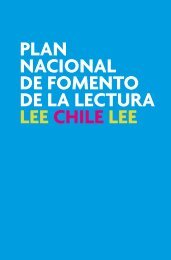
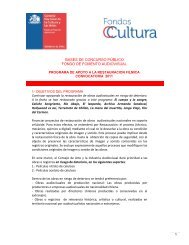
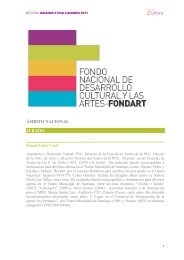
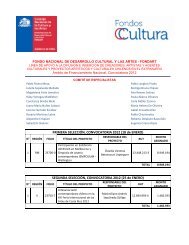
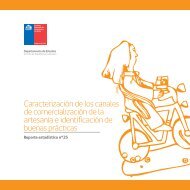
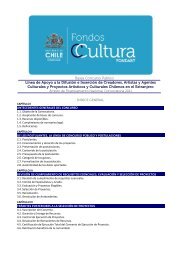
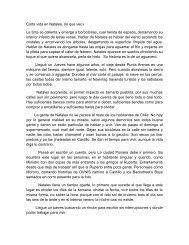
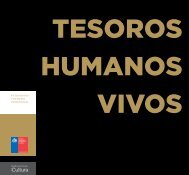

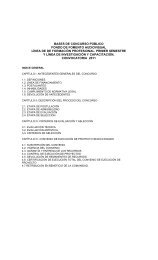
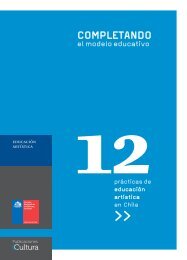

![El [difícil] arte de negociar la compra y venta internacionales de ...](https://img.yumpu.com/46971069/1/184x260/el-dificil-arte-de-negociar-la-compra-y-venta-internacionales-de-.jpg?quality=85)

